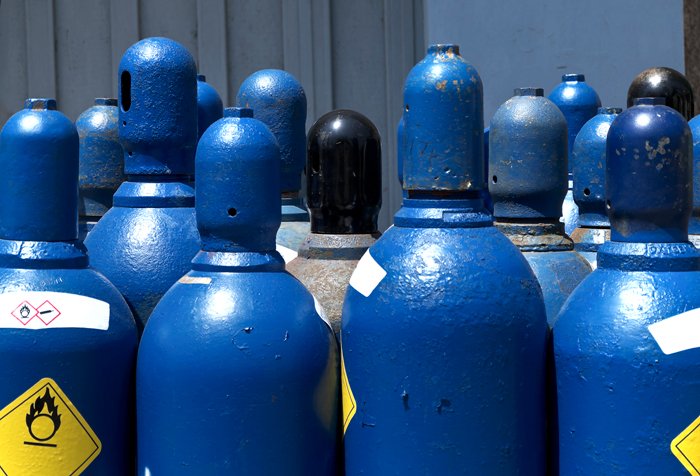We use cookies to make your experience better. To comply with the new e-Privacy directive, we need to ask for your consent to set the cookies. Learn more.
Moving and Storing Compressed Gas Cylinders Safely
If you work with compressed gas, those big metal cylinders are the most dangerous items in your facility. They can explode like bombs, fall like anvils, and even blast through the room like rockets. Plus, let's not forget, they're filled with gas that might be flammable, poisonous, corrosive, or any combination of those hazards.
But if you do work with compressed gas, nothing else can take its place. Where would welders be without oxygen and acetylene? What would a party store do without a helium tank?
With a little bit of caution and some specialized material handling and storage equipment, you can safely transport any number of compressed gas cylinders. Here's what you need to know:

- Never try to lift a gas cylinder by the cap. Instead, use a Cylinder Transporter designed specifically for gas canisters.
- Don't move cylinders by hand. That's what your cylinder cart is for.
- Take care to avoid tipping or dropping a gas container. They can crack and explode. They can also break your foot. Again, use the designated cylinder cart.
- Store gas containers in a weatherproof area with plenty of ventilation. A Cylinder Storehouse from BHS is ideal for keeping your gas containers safely locked away, even on outdoor construction sites.
- Don't jury-rig material handling equipment to move gas cylinders. The Compressed Gas Association warns users not to "handle a cylinder with a lifting magnet. It goes on to say that "slings, ropes, or chains should not be used unless provisions have been made on the cylinder for appropriate lifting attachments, such as lugs.”
We would take that last one a step further. Don't lift gas containers with chains even if they do have lugs. With a Cylinder Transporter or a Cylinder Transporter Cage from BHS, there's no reason to risk dropping one of these dangerous items. If you need to lift gas canisters, cylinder transport carts from BHS are equipped with heavy duty lift pockets. You can pick up a whole shipment of compressed gas with your standard forklift.
Plus, designated cylinder carriers keep containers from knocking against each other with steel retainer bars. That's an import safety feature. The Compressed Gas Association instructs users to keep cylinders from "[striking] against each other or against other surfaces violently."
If you need more convincing that you should only move gas cylinders with a cart that's designed for the job, listen to the Compressed Gas Association one more time: "It is safer to move cylinders even short distances by using a suitable truck," the CGA says. "Use [a] suitable hand truck, fork truck, roll platform, or similar device with cylinders firmly secured for transporting and unloading."
References:
"CGA P-1: Safe Handling of Compressed Gases." CGANet. Compressed Gas Association, Incorporated, 23 Mar. 2015. Web. 6 July 2016.
"Pressurized Cylinders: The Loaded Weapon in Your Workplace." Compliance. United States Office of Compliance, Aug. 2006. Web. 25 June 2016.
